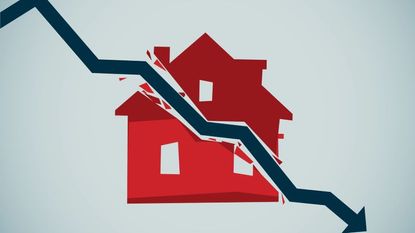The UK house price bubble hisses air
The fall in house prices has much further to go, says Merryn Somerset Webb


If you want to thank your lucky stars for something, make it that you did not think 2021 was the perfect time to buy a house in Sweden.
It might have been tempting – given that Sweden probably produced the best response to Covid in the developed world and regularly tops the global happiness ratings. But it would have hit your pocket pretty hard too: house prices are down 17% from their peak last January.
Things aren’t going so well in Canada either. There, prices have slid by 16.4% since their peak in March.
Subscribe to MoneyWeek
Subscribe to MoneyWeek today and get your first six magazine issues absolutely FREE

Sign up to Money Morning
Don't miss the latest investment and personal finances news, market analysis, plus money-saving tips with our free twice-daily newsletter
Don't miss the latest investment and personal finances news, market analysis, plus money-saving tips with our free twice-daily newsletter
The outlook for UK house prices
UK house buyers and sellers should look at those numbers carefully. Both markets were pretty similar to ours: prices were rising pre-pandemic but were then turbocharged by the race for space, the rise of working from home and the fast fall in interest rates in 2020.
In Canada, prices rose by 35%. In Sweden, they jumped by 30% and in the UK they gained more than 28%.
So if UK house prices went up in the same way, might they come down in the same way? It rather looks like it. There are many different measures of house prices, and they are all sending the same message.
Those from the Office for National Statistics (ONS) tell us that while house prices rose over the last year as a whole, they are now falling. Halifax and Nationwide also both report falling prices, while the most recent report from the Royal Institute of Chartered Surveyors tells the same sorry story.
The net balance of surveyors reporting price falls in March was 48%, a nasty acceleration from November (26%) and the worst reading since the depths of the financial crisis in April 2009.
The remortgaging reckonings are coming
This makes sense, of course. When interest rates go up, mortgage rates go up. The payments on any given amount of money you borrow then go up – reducing the amount you can afford to borrow and hence to pay for a house.
House prices then tend to fall. Interest rates and mortgage rates have gone up. A lot. The latter are down from their peaks.
The average quoted rate for a two-year fixed-rate mortgage is now around 4.3% according to Moneyfacts, down from more than 6% in October. But they are still several times higher than they were in January 2022 (when the Bank of England was still insisting inflation was transitory). Over 80% of UK mortgages are fixed-rate, but most of them are only on two-year terms.
That’s a lot of remortgaging reckonings coming, particularly given that, as Pantheon Macroeconomics says, potential buyers also have to worry about failing banks’ affordability tests. These are based on the Bank Rate, which, set as it is by a group of central bankers desperate to regain their lost reputation as great fighters of inflation, is likely to rise further from here.
Add it all up and Pantheon expects prices to fall by around 8% before all this is over. Knight Frank, treading the usual path of estate-agent optimism, thinks they will only fall 5%.
But look back to Canada and to Sweden. Doesn’t that feel like not very much? A fall that tiny would leave house prices massively higher than they were pre-pandemic, for no obvious reason (the idea that bricks and mortar might protect against inflation aside).
Other analysts think it will be worse (or better – depends on where you stand in the market), but MoneyWeek’s readers might like to pay attention to the views of Bloomberg’s John Stepek.
He reckons that a 30% fall is more likely. There are still a lot of homeowners who can’t see this coming: it is hard for anyone who has lived through a bubble to accept that it might be over.
Which is why even in the face of hard evidence that prices paid are falling, asking prices are still rising (although only just).
The latest numbers from Rightmove showed asking prices rose £14 on average from January to February.
And if you are determined to be optimistic, there are a few straws to clutch at. The first, says Marcus Ashworth on Bloomberg, is that there are plenty of products available.
In October (when things were particularly bad) there were a mere 2,250 mortgage products on offer; today there are more like 3,600.
Many of these are also five- and ten-year mortgages (which suddenly look rather more attractive than they used to!). Five years at 4.5% really isn’t that bad. There is also still plenty of cash knocking around: last year 94% of those who sold houses made a profit, with the average seller (having bought at some point in the last two decades) clearing £108,000. Those sellers may be cash buyers.
The bulls may also comfort themselves with the knowledge that house-price dips rarely last long in the UK. The 2020 crash was over before it started. The 2008 slide was nasty, but came with few forced sellers and was over in a few years: by 2012 it was as if it had never happened. But there is a problem with all this optimism. The rising interest rates.
In 2008 and 2020 rates were slashed as house prices fell. That boosted buyers’ ability to pay and hence real demand. Today the opposite is happening and is going to keep happening.
House prices were booming in Sweden until rates started to rise – last April. They were booming in Canada until rates started to rise – last March.
The UK started raising rates a little earlier (December 2021). The reaction of our housing market has clearly been slower so far, something that is probably down to the much higher proportion of fixed mortgages in the UK than elsewhere (80% here, more like 40% in Sweden and Canada), which causes a lag in the rise in interest payments.
But nonetheless, if I had to choose between John’s forecast (down 30%) and Knight Frank’s, I’d go with John’s. When rates go up, prices always go down.
Merryn Somerset Webb is a senior columnist for Bloomberg. You can follow her on Twitter and Instagram @merrynsw
Merryn Somerset Webb started her career in Tokyo at public broadcaster NHK before becoming a Japanese equity broker at what was then Warburgs. She went on to work at SBC and UBS without moving from her desk in Kamiyacho (it was the age of mergers).
After five years in Japan she returned to work in the UK at Paribas. This soon became BNP Paribas. Again, no desk move was required. On leaving the City, Merryn helped The Week magazine with its City pages before becoming the launch editor of MoneyWeek in 2000 and taking on columns first in the Sunday Times and then in 2009 in the Financial Times
Twenty years on, MoneyWeek is the best-selling financial magazine in the UK. Merryn was its Editor in Chief until 2022. She is now a senior columnist at Bloomberg and host of the Merryn Talks Money podcast - but still writes for Moneyweek monthly.
Merryn is also is a non executive director of two investment trusts – BlackRock Throgmorton, and the Murray Income Investment Trust.
-
-
 Investment trust discounts hit 2008 levels. Here’s how to profit
Investment trust discounts hit 2008 levels. Here’s how to profitInvestment trust discounts have risen to levels not seen since 2008, here are three trusts looking to buy to profit.
By Rupert Hargreaves Published
-
 A luxury stock to buy at a high street price
A luxury stock to buy at a high street priceInvestors wrongly consider Watches of Switzerland a high-street outlet.
By Dr Matthew Partridge Published
-
 Investing in wine: how Cru Wine is reaching new audiences
Investing in wine: how Cru Wine is reaching new audiencesTips Gregory Swartberg, founder of fine wine specialist Cru Wine, talks to Chris Carter about how to start a wine collection
By Chris Carter Published
-
 Small companies with big potential
Small companies with big potentialMichael Taylor of Shifting Shares reviews his 2023 picks and highlights more promising minnows.
By Michael Taylor Published
-
 The MoneyWeek portfolio of investment trusts – July 2023 update
The MoneyWeek portfolio of investment trusts – July 2023 updateTips A decade ago we set up the MoneyWeek portfolio of investment trusts. They remain a compelling long-term bet says Rupert Hargreaves
By Rupert Hargreaves Published
-
 Women lead the way with ethical investments
Women lead the way with ethical investmentsDemand for more ethical investments has soared – and women are more likely to opt for them. Annabelle Williams, personal finance specialist at Nutmeg, takes a look at why.
By Annabelle Williams Published
-
 BoE: Mortgage payments to rise by £220 a month for households
BoE: Mortgage payments to rise by £220 a month for householdsMillions of households can expect a mortgage spike of around £200 a month - and some may even reach a extra £1,000 a month, the Bank of England warns
By Marc Shoffman Published
-
 What happened to Thames Water?
What happened to Thames Water?Thames Water, the UK’s biggest water company could go under due to mismanagement and debt. We look into how the company got itself into this position, and what investors should expect.
By Simon Wilson Last updated
-
 Where to invest in the metals that will engineer the energy transition
Where to invest in the metals that will engineer the energy transitionA professional investor tells us where he’d put his money. This week: John Ciampaglia, manager of the Sprott Energy Transition Materials UCITS ETF.
By Nicole García Mérida Published
-
 How investors can profit from high food prices
How investors can profit from high food pricesThe latest furore over grocery prices will die down, says David Stevenson. But the long-term outlook for soft commodities remains bullish. These are the stocks investors can buy to profit from high food prices.
By David J Stevenson Published









